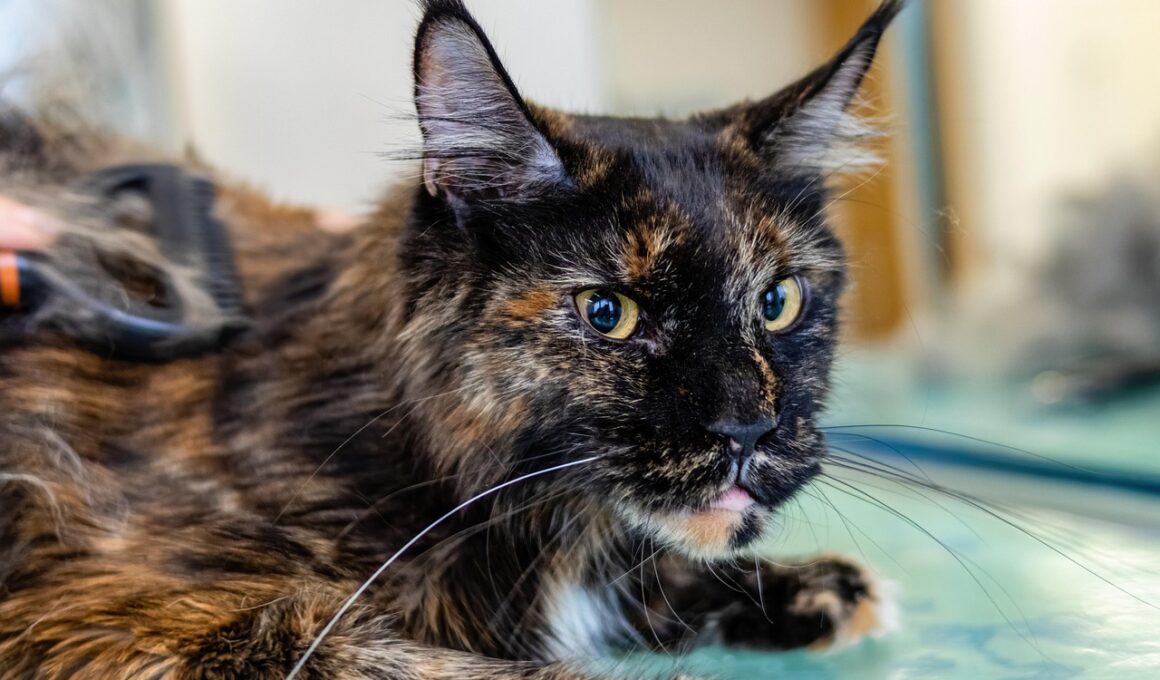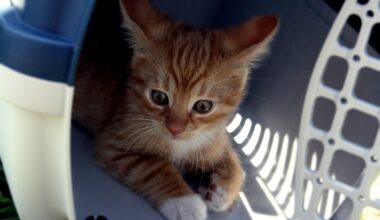Top 10 Grooming Tips for Senior Cats
As our feline friends age, their grooming needs become more significant. Senior cats often experience changes in their skin, coat, and overall health. Regular grooming is crucial to ensure they remain comfortable and healthy. Begin by selecting the right tools for grooming, which may include a soft-bristle brush, a comb, and clippers if necessary. A gentle approach is essential; older cats may have more delicate skin that requires extra care. This helps prevent irritation during grooming sessions. Additionally, consider the frequency of grooming based on your cat’s specific breed and coat type. Short-haired cats may require less frequent grooming than long-haired breeds. Paying attention to your cat’s comfort and stress levels is crucial, as older cats may not tolerate grooming for extended periods. If your cat shows signs of discomfort, it’s essential to break sessions into shorter intervals. Offering treats may help create a positive experience for both you and your pet. Remember that grooming not only keeps your cat looking good but also aids in maintaining their overall health and well-being, especially as they transition into their senior years.
Senior cats may struggle with mobility, making regular grooming particularly important for them. Regular grooming allows you to inspect your cat’s skin for any unusual lumps, bumps, or skin irritations. These inspections can help catch health issues early. Use soft brushes to remove loose fur and reduce shedding during brushing sessions. Senior cats are often more prone to mats and tangles, so be attentive and work on these tangles with a comb or even your fingers if necessary. Additionally, ensure your senior cat gets plenty of fluids, as this can help in maintaining a healthy coat. Hydration is key, as dehydration can lead to skin problems. Ensure their water supply is always fresh and plentiful. Also, consider a diet rich in essential fatty acids that promote healthy skin and coat. Supplementing their diet with omega-3 fatty acids can make a significant difference. Consult your veterinarian about the best diet for your senior cat. Grooming sessions can also provide an opportunity for bonding, creating a trusting relationship between you and your furry companion. A relaxed environment during grooming is essential to help seniors feel secure.
Bathing Options for Senior Cats
While bathing may not be a routine activity, it can be beneficial for older cats who are unable to groom themselves fully. However, bathing should be performed with great care and only when necessary. To prepare for bathing, gather all necessary supplies: a gentle cat shampoo, towels, a non-slip mat, and a shallow container or basin for rinsing. Make sure the water temperature is lukewarm, as senior cats can be sensitive to extreme temperatures. During the bath, keep it brief to minimize stress, and speak gently to reassure your cat throughout. If your cat appears anxious, take breaks or consider using cat wipes instead, which can be a great alternative to baths. Proper aftercare is equally important; always dry your cat thoroughly using towels to prevent chilling. Their health is paramount; make sure they’re not exposed to drafty areas after bathing. Regular bathing can help with matting and skin issues. Speak to your vet regarding how often your senior cat may require a bath based on their specific grooming needs and health concerns. Paying attention to your cat’s reactions can help tailor the bathing experience for them.
Another significant aspect of grooming senior cats is nail trimming, which may not require frequent attention but should not be neglected. Older cats may become less active, leading to slower nail growth; however, keeping their nails trimmed is essential for their health. Untrimmed nails may become overly long, causing discomfort and potential injury. Use cat-specific nail clippers, as these are designed to minimize stress for your cat. When trimming, be careful to avoid the quick, which is the pink part of the nail that contains blood vessels. If you are unsure how to trim nails safely, consider asking your veterinarian for a demonstration. Regular nail trims can also prevent scratching and damage to furniture. Additionally, providing scratching posts can help maintain nail health. Encourage your cat to use them by placing them in accessible areas. Regularly checking and maintaining your cat’s paws can help you identify any problems, such as infections or foreign objects stuck between their toes. This attentive care improves their comfort and mobility, allowing them to enjoy their golden years to the fullest. Trust your instincts and make nail care part of your grooming routine for senior kitties.
Dealing with Dental Hygiene
Dental hygiene is another critical yet often overlooked aspect of grooming senior cats. Cats are prone to dental issues as they age, which can lead to painful conditions and further health complications. A disrupted oral environment can significantly affect their overall health. Regular dental care can help prevent periodontal disease, which is common in senior felines. Consider incorporating daily teeth brushing into your grooming routine, using toothpaste specifically formulated for cats, as human toothpaste can be toxic to them. If your cat resists having their teeth brushed, try introducing dental treats or dental health products designed to reduce plaque. Many veterinarians offer professional dental cleanings as well, so schedule these appointments regularly. Monitor your cat’s breath, as bad breath can be a sign of dental issues. Keep an eye on their eating habits; difficulty eating or loss of appetite may signal potential dental problems. Ensuring good dental hygiene not only keeps your cat comfortable but can also contribute to their overall general health. Speak to your vet for personalized advice on maintaining your senior cat’s dental hygiene, as their needs may differ from younger cats.
Another essential aspect of senior cat grooming is coat care. Many senior cats experience changes in coat texture and density, often becoming matted or dry. Regular grooming helps maintain a healthy coat, ensuring your cat remains comfortable and looking good. For long-haired breeds, daily brushing is often necessary to prevent mats from forming. Mats can pull at the skin, leading to irritation and pain. Be gentle during sessions, using a wide-toothed comb to tackle larger tangles. It’s also important to assess your cat’s coat condition; dry or flaky skin may require an adjustment in diet or bathing routine. Use grooming products designed for older cats that soothe and nourish their skin. Additionally, ensuring your cat’s environment is kept clean can prevent dirt and debris from affecting their coat. Vacuuming regularly in areas your cat frequents can help minimize allergens like dust and hair. You may also consider using a grooming glove, which can effectively remove loose hair while providing a gentle massage. Encourage your cat to have positive experiences during grooming time to build trust and calm them during these sessions, especially if they are anxious or sensitive.
Creating the Right Environment
Your cat’s environment plays a significant role in their grooming experience and overall well-being. Setting up a cozy grooming space can minimize stress and anxiety as you groom. Choose a quiet area of your home where your cat feels safe and comfortable, free from loud noises and distractions. This tranquility allows both you and your cat to focus on grooming without interruptions. You may want to use a soft mat or blanket to create a familiar and warm spot. This can encourage them to relax during grooming. While grooming, take breaks if your cat becomes anxious; their comfort is more important than finishing a session quickly. By allowing them to explore the area or have a few moments of quiet, you foster a sense of calm. Additionally, interacting with your cat through gentle pets can enhance their mood and create a positive atmosphere. Consider the use of calming diffusers or sprays designed for pets to help soothe anxiety during grooming. Providing regular care and attention to your senior cat in a calming environment will contribute to their happiness and health, deepening the bond you share.
Staying up-to-date on veterinarian visits is crucial in maintaining your senior cat’s grooming health. Older cats require more frequent check-ups to monitor their overall health, including grooming-related concerns. During these visits, ask your veterinarian questions about your cat’s specific grooming routines and any concerns you may have noted during grooming sessions. Many medical conditions can affect a cat’s grooming habits, and being proactive can result in early detection and treatment. Keeping a log of your cat’s changes in behavior can help the vet understand their condition better. Discuss any findings from your grooming sessions, such as unusual skin changes or behavior types. This information can be incredibly valuable in assessing your cat’s health. Regular vet visits also give you the chance to discuss dietary changes that can positively affect your senior cat’s grooming and overall health. Investing in your cat’s health through regular check-ups and open communication with veterinary professionals is an essential aspect of responsible pet ownership. By prioritizing grooming and healthcare, you’ll ensure your beloved cat enjoys their golden years, remaining happy and healthy for as long as possible.


